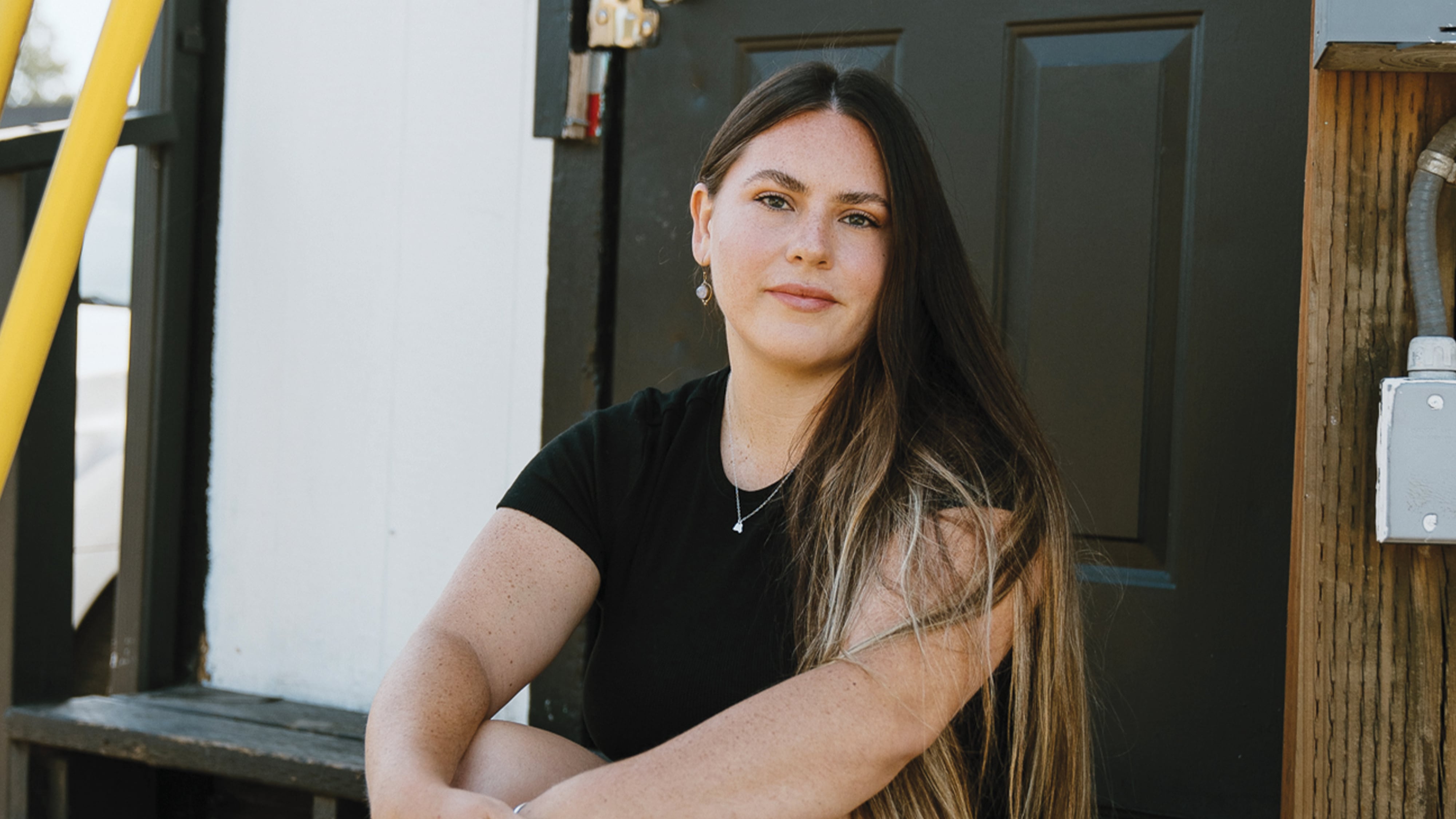Heading east toward 82nd Avenue, Portlandia fades away.
Instead of artisanal bone-broth shops, there is fast food. In place of vegan strip clubs, prostitutes ply their trade in front of aging motels. Cannabis boutiques with jewelry cases full of bright green buds give way to bodegas selling kratom. Luxuriant shade trees are fewer and farther between. Craftsman bungalows become tougher to spot.
Portlandia was fiction. These days at least, close-in Portland seems less precious than it was in the imaginations of Fred Armisen and Carrie Brownstein. The pandemic and riots certainly wiped away some of the gloss. Still, there are signs of twee life. Members-only Soho House opened recently, a Seattle developer is building a five-story “immersive wellness sanctuary” on Northeast Alberta Street, and a cheese shop called Caseus Diem (“cheese the day”) is coming to Southeast Division Street, with 75 varieties.
Not so in East Portland.
Like many lower-rent neighborhoods (Brooklyn, N.Y., once upon a time), East Portland is a giving tree. It’s very likely home to the barista who foams your latte on Hawthorne Boulevard, the guy who loads your suitcase into the belly of a British Airways flight to London, and the paramedic who arrives at your elderly mother’s door at midnight when she’s short of breath.
It’s a part of Portland where there is also room for Costco, and for the freight warehouses that stage your Amazon packages for next-day delivery.
And where else does Portland renew itself with immigrants from Africa, Asia, Latin America and Slavic Europe, whose rich cultures and grit keep Portland vibrant?
The answer is East Portland; and, thankfully, the place is about to get some overdue attention. In August, the sprawling region got a new name: District 1.
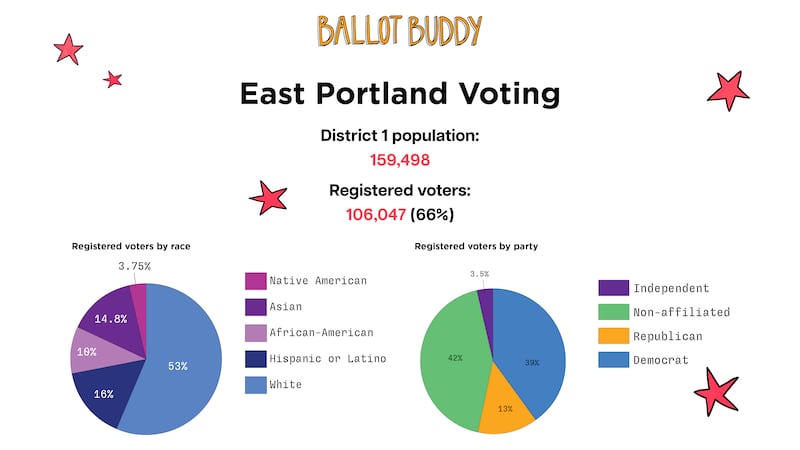
There are three other districts, representing, roughly, Southeast Portland, North and Northeast, and the westside. In November, Portlanders will choose from long lists of candidates with ranked-choice voting that eliminates primaries and runoffs and applies fancy math to spit out three winners in each district.
Amplifying the voices of East Portland was one of the main reasons for the overhaul.
If East Portland’s new representatives prove competent, they could bring real change when they take office in January. Since 1913, Portland has had a rare, goofball form of government made up of four commissioners and a mayor, all of them elected citywide, and all of them occupied with managing city bureaus that critics say stole their attention from struggling neighborhoods.
As the crow flies, East Portland is farther from City Hall than any of the other districts; and, to residents, it often felt that way policywise, too. For all its (underappreciated) charms, East Portland can be a tough place to live. You’re more likely to get shot in East Portland than you are anywhere else in the city, save for a few mean streets in downtown Portland. Cars kill more pedestrians out here, as does unshaded summer heat.
The conditions are a direct result of neglect, as WW has reported in stories dating back more than a decade (“The Other Portland,” Oct. 12, 2011). City leaders left East Portland’s needs at the bottom of their to-do list. Neighborhoods east of 82nd Avenue have more unpaved roads than any other part of the city. Tit-for-tat gang shootings often go unsolved. Last year, 30 Douglas fir, Japanese maple and redwood saplings planted in Mill Park died because the Portland Bureau of Transportation simply didn’t water them.
Income per capita is lower across East Portland. The median income in District 1 is $61,000, compared with $90,000 in District 2 (North-Northeast), $84,000 in District 3 (Southeast), and $94,000 in District 4 (westside).
A greater proportion of people with disabilities live in East Portland than anywhere else in the city: 16% compared with 10% to 12% in the other districts. Some 15% of East Portlanders are food insecure, up from 10% to 11% elsewhere. People in East Portland can expect to live to 77, compared with 81 in District 4′s westside neighborhoods (see more charts, page 15).
“You feel like you have to be always looking for your back because you don’t know what can happen,” Luis Bravo, a manager at an East Portland Burger King, says.
Going left to right on a map, Portland’s westside would logically be called District 1, with Districts 2 and 3 coming next, and District 4 at the easternmost edge. But the 13-member Independent District Commission numbered things the opposite way—perhaps a signal of the higher priority reformers sought to give East Portland.
That commission drew the districts, balancing them by population and being mindful of natural boundaries. It followed a 20-member Portland Charter Commission that designed the new government structure.
“We looked at things like how many registered voters are there, how many people vote, where are the school districts, where are the shopping areas, what are the ethnic and cultural enclaves?” Arlene Kimura, a retiree who served on the redistricting commission, says. “Many people thought we would just look at neighborhood boundaries, but we did not just do that.”
District 1 stretches from Portland International Airport, east to the Gresham city limits, and south to Happy Valley. It includes leafy Parkrose and the winding streets of Argay Terrace in the north to Lents Park and verdant Powell Butte to the south.
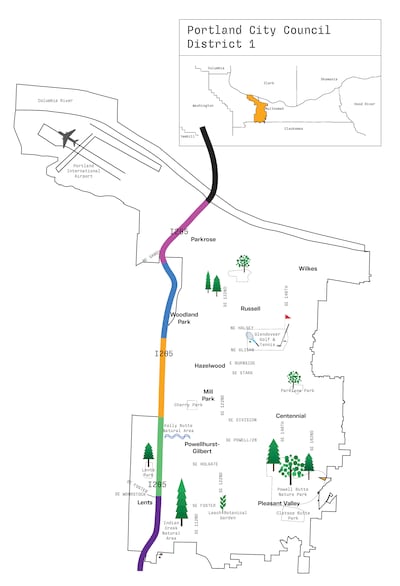
Charter commissioners aren’t shy about saying that East Portland was top of mind when they brainstormed what better representation might look like.
“We wanted to make people feel that their vote would count,” says Melanie Billings-Yun, a now-retired Portland State University professor who served on the Charter Commission. “We felt we needed to create a system that was fair and inclusive for all.”
The commission started its work in the wake of the George Floyd protests and the pandemic, when equity was the talk of the town. No section of the city was more in need of rebalancing than East Portland, they reasoned. Suddenly, the most diverse, and the most downtrodden, part of Portland was being seen. Many of the charter changes were aimed squarely east. With three city councilors in each district, and ranked-choice voting, candidates who may have been run over by big money and expensive consultants would have a real shot, they said.
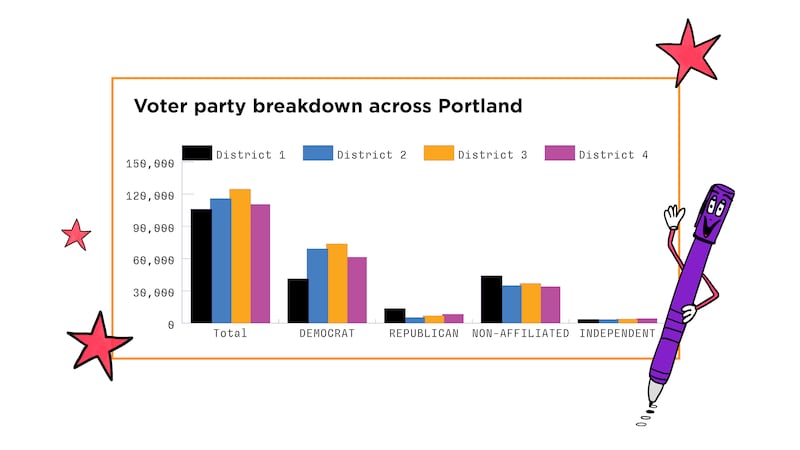
“Ranking our candidates in order of preference is a growing voter reform movement across the country because it has been shown to increase participation in voting, expand the diversity of viewpoints and identities in elected office and improve voter satisfaction,” charter commissioner Candace Avalos wrote in an op-ed column in The Oregonian in October 2022, before Portlanders voted on the overhaul.
Avalos, 35, who runs environmental justice nonprofit Verde, hopes to be part of that diversity. She’s running for City Council in District 1. The tagline for her campaign is “A Champion for East Portland.”
But East Portland may surprise well-intentioned progressives like Avalos. It is more diverse than the other four districts, but voters there have some tough-on-crime tendencies. Rene Gonzalez, a private-sector lawyer who ran as a friend of cops and a clearer of tents, outpolled Avalos ally Jo Ann Hardesty in their November 2022 race for City Council. Gonzalez beat the incumbent Hardesty by 5 percentage points, helped by a 63%–37% split in East Portland. By contrast, only 47% of District 3 voters in inner Southeast Portland cast a ballot for Gonzalez.
Fast forward to May 2024, when District 1 voters were asked to choose between incumbent Multnomah County District Attorney Mike Schmidt, a criminal justice reformer, and rival Nathan Vasquez, who promised stiffer penalties for petty crime and a crackdown on public drug use. Vasquez took 57% of the vote in District 1, compared with 46% in Districts 2 and 3.
“Of the City Council districts, this is one of the most conservative,” says Doug Moore, executive director of United for Portland, a group started by the Portland Metro Chamber that supports City Council candidates, such as former Mayor Sam Adams, who are to the right of Avalos and other reformers.

The recent results pose the question: What do East Portland voters want from their new-fangled, state-of-the-art City Council?
To answer that question, we spent two weeks roaming the streets of Argay Terrace, Mill Park, Hazelwood, Foster-Powell and Lents, dodging potholes and roasting in the heat-island sun, just like the locals do, every single day. We visited Burger Kings and auto shops, public pools and parks, apartment complexes and retirement homes.
We’ll be doing the same reconnaisance in the other three districts in coming weeks, as part of Ballot Buddy, our guide to the coming election and the changes it brings. But we started here, in the place that architects of Portland’s new government hope to elevate.
On the pages that follow, we let the people we met tell you what they want.
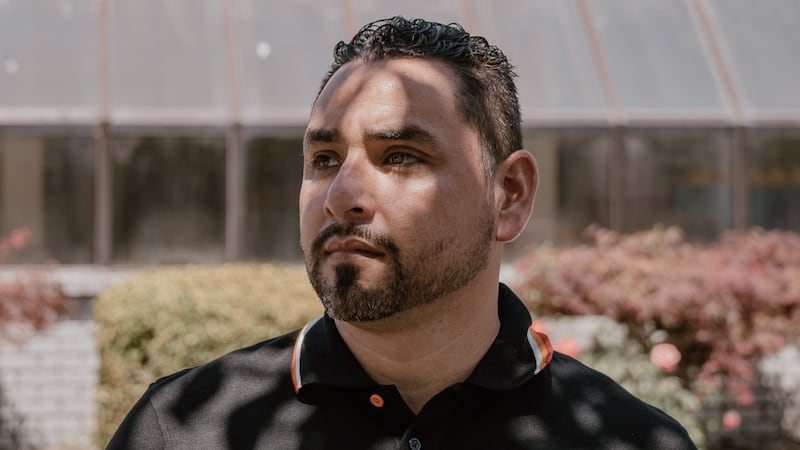
LUIS BRAVO
It takes patience and resolve to manage a Burger King in East Portland. Luis Bravo, whose store is on Southeast 100th Avenue, knows that firsthand.
He came to work one morning this summer and found a homeless man loitering outside.
“I asked him nicely to leave,” Bravo says. The man called him a “son of a bitch” and told him to go back to his country. Bravo’s country is the United States, where he has lived since he was 7 years old.
Bravo, 37, lives in the Parkrose neighborhood with his wife and four young children. He’s worked at Burger King since 2007 and started managing this location last year. It sits between Stark and Washington streets, two busy, one-way thoroughfares that make the place feel like a pit stop on a Formula One track.
Bravo would like Portland’s new city councilors to improve public safety. Police aren’t as prompt as they used to be, he says. Case in point is the man who cursed him a few weeks ago. Bravo called the police…and waited for two hours. By the time police arrived, the man had moved on.
“There are some days when you come to work and everything is smooth and clean and there are no homeless [people] around the store,” Bravo tells WW. “But some days there are people trying to get free food or breaking windows or trying to argue.”
Bravo says he’s conflicted about how to handle the poverty on display outside the Burger King. Homeless people coming in to use the restroom often leave it trashed, he says, making an extra mess for Bravo and other workers to deal with and driving customers away.
“I want to be nice,” he tells WW, “but I feel like they don’t care.” ELIZA ARONSON.
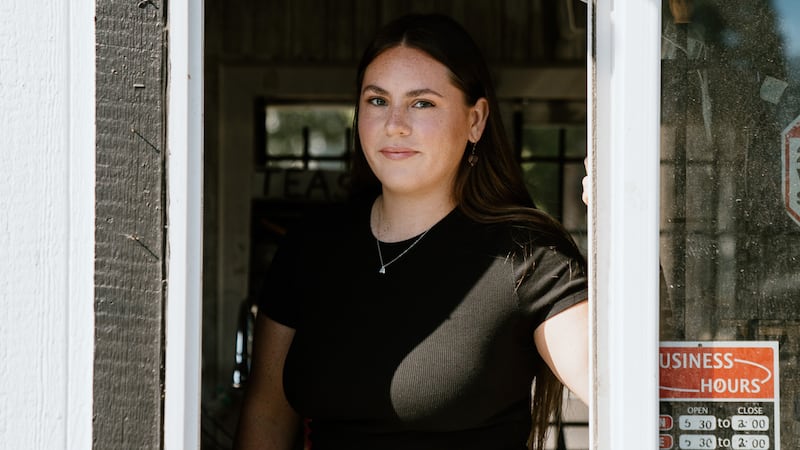
HEAVENLY HEDENBERG
What should East Portland’s new councilors work on first? Bullets and potholes.
That’s according to Heavenly Hedenberg, 27. She’s lived in the Lents neighborhood for 15 years. A few months ago, she started working at Rip City Coffee, a tiny drive-thru coffee shack at the corner of Southeast Foster Road and 101st Avenue. Her regular gig is serving as a personal assistant to a psychotherapist with multiple sclerosis. But when the job at Rip City arose, Hedenberg took it as a way to get back into the coffee scene. She hopes to eventually open her own shop.
“There was a weekend where there was apparently a big shootout right there, with four different cars in the middle of the night,” Hedenberg says, pointing to cars whizzing through the intersection. “Like, hundreds of bullets.” (WW could not independently confirm that story by press deadline.)
Shootings have fallen since the pandemic. Citywide, there were 432 in the first six months of this year, down from 543 in the same period last year and 674 in 2022. Lents, where Hedenberg’s coffee shop is located, accounted for 19 of them, and Powellhurst-Gilbert, just northeast of the shop, had a whopping 39.
The roads in East Portland lag, too. Hedenberg doesn’t need statistics to prove that.
“This road sucks with all the potholes,” she says. It makes sense, she says, because the neighborhood is filled with warehouses served by heavy trucks.
One more concern: homelessness. People who live outside often come to the drive-thru for water. The staff has gotten to know a man who comes to collect their cans.
“But not everyone is as nice and respectful as he is,” Hedenberg says.
She wants change, so this year she’s going to go down ballot and vote for City Council candidates. In years past, she’s often stopped at the top of the ticket.
Her modest plea to the future City Council: “Figure out the homelessness and fix the roads.” ELIZA ARONSON.
OLGA SCHEGLYUK
Location is everything.
Olga Scheglyuk’s ground-floor apartment is about 400 feet from the Portland Police Bureau’s East Precinct and just across from the East Portland Community Center. Having them nearby means that Scheglyuk’s neighborhood isn’t lined with tents or cars doubling as shelter.
Even so, the neighborhood is more blighted now than it was seven years ago, when she moved here. Crime, drugs and homelessness are all worse, she says. People sleep on her street and sometimes wander the neighborhood, listless and naked. Cars get broken into.
“It used to be bad,” Scheglyuk says, “but not like that.”
Scheglyuk, 71, is no snowflake. She immigrated to Oregon in the 1990s to escape religious persecution in her native Ukraine, where she grew up under Soviet austerity. She worked as a records clerk for Providence Hospital. Her grandson, 25, shares her apartment.
Recently, her neighbor’s car was stolen and was found “full of needles.” Rattling her own door as a demonstration, Scheglyuk says a man tried to enter a neighbor’s house recently.
East Portland, she says, seems to be faring worse than other places in Oregon.
“I go to Lake Oswego,” she says. “My sister lives there. Wonderful, no problem at all. My grandson lives in Oregon City. Wonderful. Why do we have all this? It’s just scary.”
She stays in part because of her community, which sustains her. She’s been attending mass at the Slavic Evangelical Church Sulamita for 33 years. It has over 2,000 members, all of them Slavic. She knows the pastor, and has lots of friends there.
What would she like from the new city councilors in East Portland? A greater sense of security. More than anything, she’d just like to feel safe in her home.
“People can be safe,” Scheglyuk says. “We don’t feel safe here.” LIN LIN HUTCHINSON.
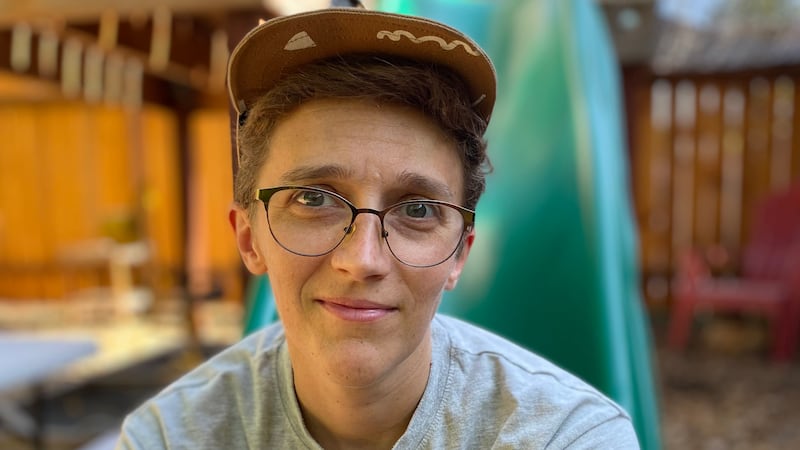
KATE GIAMBRONE
Kate Giambrone, a graphic designer from Pittsfield, Mass., has lived in the Lents neighborhood for a decade. In that time, she has seen cars crash into buildings and houses burn down. Like lots of other people in East Portland, she’s heard gunshots.
“Someone was murdered just a few streets away from where I live,” Giambrone, 39, says.
Despite all that, she doesn’t feel unsafe. But East Portland clearly feels neglected, she says. She hopes the three new city councilors devoted to the district will bring change east of Interstate 205, as promised by the people who wrote the new city charter.
“I feel like we aren’t examining actual solutions or changing the way we’re solving things,” she says on a walk along the heat wave-cooked multiuse path that parallels I-205. The route, one she bikes from time to time, is tagged with graffiti and littered with torn clothing and plastic packaging.
Giambrone’s biggest concerns are affordable housing (she owns her place) and safe streets. She points out houses that have been hit by wayward vehicles over the years. Too often, she sees cars speeding down residential streets at ridiculous speeds.
“There aren’t any sidewalks past 103rd Avenue,” she says. “You just walk on the side of the road. Good luck, I guess.”
Another thing that would make life better in East Portland? More foliage. East Portland has less than half the tree cover that the west side of the city does. The farther east you go, the barer it gets. Shade is hard to come by, making heat waves miserable—and deadly. At least 22 East Portlanders died in the summer of 2021 when temperatures hit a staggering 116 degrees.
“Put the tree on the damn truck and drive it here,” Giambrone says.
But East Portland is home, and, like many of her neighbors, she doesn’t want to see it lose its charms. Many of the houses along her walk have front-yard vegetable beds surrounded by bright perennials, and she loves the people.
“We don’t want it to turn into any other Portland neighborhood,” Giambrone says. VERONICA BIANCO.
JENNY STINE
Jenny Stine sits on the curb of the cul-de-sac, smoke rising from the cigarette between her fingers. She watches tenants of the Lafayette Court Apartments, the low-income building she manages, come and go in the parking lot, enjoying the cooler summer evening after a scorching day.
Like many other District 1 residents, Stine faces daily dilemmas with homelessness and drug use. There’s a flimsy guardrail between her tenants, whom she’s eager to help escape addiction and housing insecurity, and other impoverished people who, sadly, make Stine’s job harder.
“I’m seeing things I haven’t seen in years pop up again,” Stine says. Homeless people pose as tenants and sleep in common areas. Her teenage daughter has been offered drugs in broad daylight.
The new Rosewood Family Health Center, which stands across from Lafayette Court, has helped, Stine says. The streets are lit better now, and the trees around the place are neatly trimmed.
“That was the best thing ever for this neighborhood,” she says.
Still, an RV and tents sit across the street, where, Stine thinks, drug deals are common.
Public service is in Stine’s DNA. Prior to managing a low-income apartment building (no easy task), Stine worked as a lunch lady at Jackson Lee Elementary and helped onetime City Commissioner Chloe Eudaly pass renter protections.
“That [renter protection] has helped. But it doesn’t help the extremely low income,” Stine says. Subsidized studios go for $1,100, still out of reach for people supported by Social Security Disability Insurance. She sees that kind of housing insecurity up close.
Stine hopes that having city councilors dedicated to East Portland will make the new District 1′s woes more apparent to the political class.
“There are those living in cars or living with families,” she says, “that are so well hidden that they’re not getting the attention.” LIN LIN HUTCHINSON.
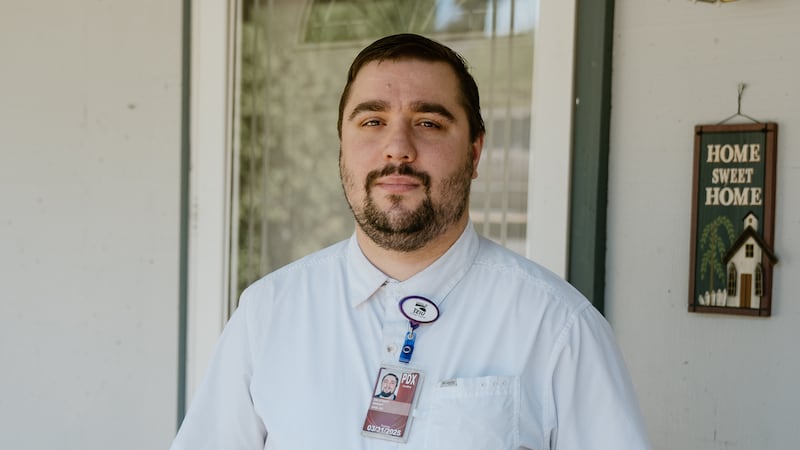
SERGI ZALUTSKIY
Sergi Zalutskiy would like to take his three young kids out to play more often, but he’s wary of exposing them to things they might see in East Portland, like the naked man who once ran around his Powellhurst-Gilbert neighborhood.
“It’s hard for me to take my kids out because I just don’t know what’s going to happen,” Zalutskiy, 34, says in a telephone interview.
Zalutskiy works at Portland International Airport, where he’s a wheelchair agent, taking people from check-in, through security, and on to their gates. He’s been at it for five years. He’s lived in various places in Portland and the suburbs, and just last year moved to Southeast Powell Boulevard, where he rents a house with his wife and kids.
Homelessness and crime are Zalutskiy’s big concerns. One morning at the bus stop, a man tried to steal his phone. The man persisted, chasing him.
“I had to run back and forth trying to lose him,” Zalutskiy says.
Since then, he no longer takes the bus to work. He drives every day now, on East Portland’s pot-holed roads. Like so many stretches, a side street near him isn’t paved.
“I feel like I’m in a Third World country because it’s so bumpy,” he says.
Unlike too many people, Zalutskiy votes in city elections. He hopes the three new city councilors—bound by the new charter to represent just East Portland—will do better than the current four, who are supposed to represent everyone in the city.
“I’m excited for how they’re changing,” Zalutskiy says. “I feel like the city government hasn’t been working for us.” ELIZA ARONSON.
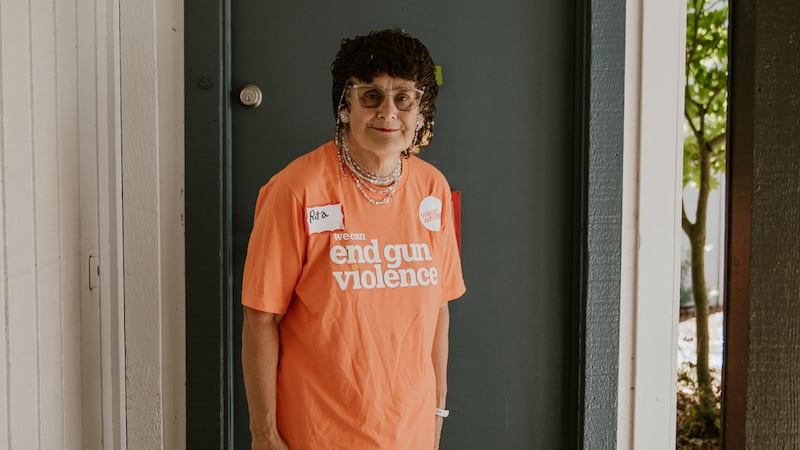
RITA MCCARTY
Rita McCarty’s apartment living room in the Argay Terrace neighborhood is filled with teddy bears, twin pictures of Presidents Barack Obama and Joe Biden, and bird magnets.
At the front door of her small apartment are garbage bags filled with empty cans ready for redemption—it supplements her monthly Social Security checks. McCarty, 75, learned to be financially scrappy growing up in a poor family in Oregon.
For 43 years she worked as a hardware finisher for a furniture company before losing her job during the 2008 financial crisis. She has lived in the Hidden Oaks apartments since 1996. McCarty’s biggest concern, at least in recent years, has been gun violence.
It first hit close to home, literally, when she was awoken by the sound of gunshots above her apartment, a year ago. She regularly hears gunshots these days—one happened just past there, she says, pointing at the courtyard outside her kitchen window.
“We heard some shooting down there, towards Sandy,” McCarty says. “It was just last week at 3:25 in the morning. Bang, bang, bang.”
McCarty , who worries about others’ well being, does not sit idly by. She recently emailed Sen. Ron Wyden (D-Ore.), Mayor Ted Wheeler, Gov. Tina Kotek, and the Portland City Council with multitiered action plans outlining her thoughts about those deemed eligible to own a gun. Last year, she helped her church, Parkrose Community United Church of Christ, to secure land across the street that is now a tiny pod village with 11 units of transitional housing.
One thing she’s not too excited about: the Prologis freight warehouse planned at the site of the former Kmart where Proud Boys and antifascists brawled in 2022.
“I hope it won’t be so noisy, especially for the people that live awful close,” McCarty says. “They need to sleep because they got to get up and go to work and there’s elderly people living there. Some of them’s health is not too good.” LIN LIN HUTCHINSON.
MELKE TADESSE
The Ebenezer Ethiopian Church is an East Portland landmark. Its gray spire towers over the tidy, working-class houses in Parkrose Heights, making the church visible for miles. Ethiopian families come from all over the metro area for sermons and singing in their native Amharic.
Pastor Melke Tadesse, a trim man who is soft-spoken but attentive and passionate, has been preaching Sunday sermons to the congregation for about a year. Like all Christian faiths, the Ethiopian church follows Christ’s teachings about the poor: They are blessed, and the kingdom of God belongs to them.
But sometimes East Portland tests Tadesse’s patience. Homeless people, he says, break the church’s windows, sneak in to use the restroom, and often sleep in the doorways. He understands their plight, but he also has a flock to protect.
“We are highly wary,” Tadesse says. “We have children here. We respect every individual, but we want to be respected too.”
Like many people in East Portland, Tadesse and his congregants feel ignored by City Hall, which is just 9 miles away by car but feels much farther, given the neglect.
“No one asked us what is going on around us,” Tadesse says in an interview in the church’s pew, lined with rows of maroon fabric and metal chairs. “The problem is known and clearly seen, but we don’t see any action.”
By many measures, Parkrose is faring better than many East Portland neighborhoods. It has suffered far fewer shootings than Hazelwood, just to the south. There were 27 in Parkrose in the past 12 months, compared with 66 in Hazelwood, according to the Portland Police Bureau.
Median household income in Parkrose jumped 34% to $60,278 in 2022 from $45,128 in 2017, in line with gains around the metro area, but people still feel strapped, Tadesse says. Groceries are more expensive than they were before the pandemic, and rents have risen.
The church itself struggles to pay rent on its building (it’s owned by the Parkrose United Methodist Church). During the interview, Tadesse apologizes for the lack of air conditioning.
“We’re trying to work on getting more money,” he says. ELIZA ARONSON.
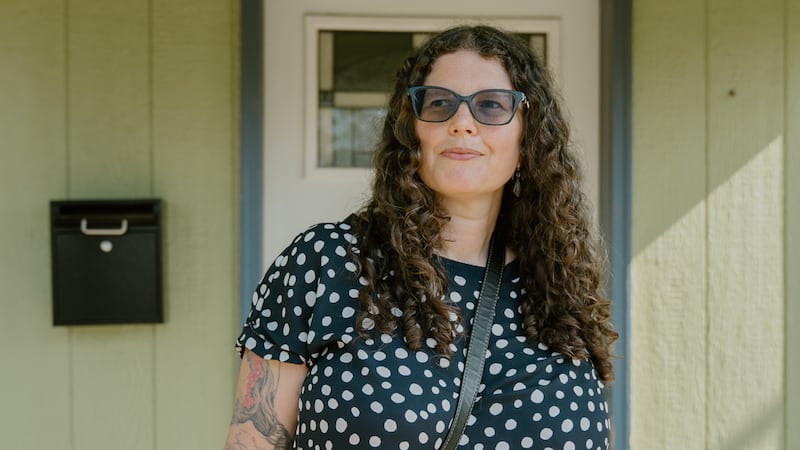
MEGAN DART-MCLEAN
Megan Dart-McLean, 45, moved to Lents five years ago because she could afford to buy a house there with help from the city’s Down Payment Assistance Loan program.
Home ownership and Lents make her happy. A year after she settled down, she gave birth to her son. He’s 4 now and goes to preschool near their house.
The neighborhood feels safe, mostly. Like many East Portlanders, she worries about speeding drivers. Crash data supports her concern. In 2023, the traffic fatality rate in East Portland was 15 per 100,000 residents, compared with 9 per 100,000 in the rest of the city. About a third of the deaths were pedestrians.
Two years ago, Dart-McLean woke up at midnight to find that a driver had lost control and crashed into a parked car on her street. Another time, someone drove into a nearby house.
“I just have to tell my son, don’t walk in front of a driveway, don’t cross the road by yourself, don’t trust any drivers to stop,” she says.
A related issue: Neighbors letting a fishy RV park next to her house.
“I can’t say they were having a drug deal, but it looked like that,” Dart-McLean says. “When I’d go jogging I’d bring my Mace, and we don’t walk on that side of the street anymore.”
Still, Lents is home. Her neighbors are friendly. It’s a good place. She’d like the city’s leaders to police the RVs and add some sidewalks. Simple things. She hopes the bigger council, with dedicated representation in East Portland, will get those jobs done. VERONICA BIANCO.
Correction: This story initially misidentified the commission that numbered the districts. It was the Independent District Commission, not the Portland Charter Commission.
 This article is part of Willamette Week’s Ballot Buddy, our special 2024 election coverage. Read more Ballot Buddy here.
This article is part of Willamette Week’s Ballot Buddy, our special 2024 election coverage. Read more Ballot Buddy here.
